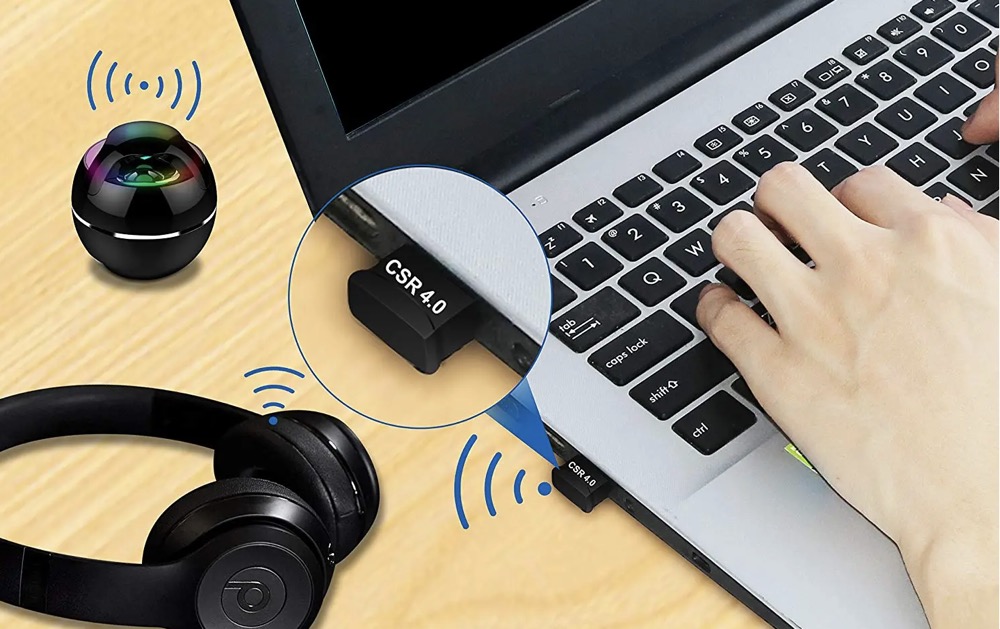This minhour teaches you how to enable Bluetooth functionality for a computer that doesn't support Bluetooth by using a Bluetooth adapter. While the majority of modern computers incorporate Bluetooth functionality into their default hardware, you can use a Bluetooth adapter (or "dongle") to enable Bluetooth for computers that don't - or won't - use built-in Bluetooth.
Setting up the Dongle
Buy a Bluetooth dongle.
If you haven’t already bought a USB Bluetooth adapter, find one that works with your specific operating system (e.g., Windows 10 or macOS High Sierra) and purchase it.
- You can usually find Bluetooth adapters in stores such as Best Buy and on sites such as Amazon. Bluetooth Dongles can cost anywhere from $3 to $30. Make sure you purchase an Bluetooth dongle with good drivers that supports Bluetooth 4.0 or higher.
- Bluetooth 5.0 adapters are more expensive, but offer greater range and speed. Bluetooth 4.0 adapters are a little cheaper and will work fine for most applications.
Find a free USB port on your computer.
You’ll need an empty USB port into which you can plug your Bluetooth adapter.
- If your computer uses oval USB-C ports instead of rectangular USB 3.0 ports, you’ll also need to buy a USB to USB-C adapter for your computer.
Plug the dongle into your computer.
It should fit snugly into the free USB port.
- If you’re using a USB to USB-C adapter, first plug the USB-C end of the adapter into your computer, then plug the Bluetooth dongle into the free end of the USB adapter.
Install any necessary drivers.
Windows 8 and 10 will most likely recognize the Bluetooth dongle automatically. If your Bluetooth dongle won’t run on your computer, it may be because the latest version of your operating system doesn’t support it. You can install the latest drivers using the install disk that came with the dongle or by downloading them from the manufacturer’s website.
- To download the drivers from the manufacturer’s website. Use Google to search for the product name and “Drivers”. Click a search result that leads to the manufacturer’s official websites. Click the option to download the drivers. Once the installation file is downloaded, locate it in the Downloads folder. Double-click the installation file and follow the instructions.
Using Bluetooth on Windows
Turn on your Bluetooth item and place it in pairing mode.
A Bluetooth device can be a mouse, keyboard, headphones, speakers, or a wireless controller. Power the device on and put it in Bluetooth Pairing mode. Consult the user’s manual to learn how to put your particular device in pairing mode. Typically there is a button you press and hold.
- In some cases, turning on your Bluetooth item will automatically place it in pairing mode.
Click the Bluetooth icon in the Windows taskbar.
It’s a blue icon with a symbol that resembles a jagged “B”. This displays a pop-up menu. It’s on the right-hand side next to the time and date.
- If you don’t see the Bluetooth icon, click the up arrow to display all taskbar menu items.
Click Add a Bluetooth Device.
It’s at the top of the pop-up menu. This opens the Bluetooth and Other Devices Settings menu.
Turn Bluetooth on.
If Bluetooth is not already turned on, click the toggle switch below “Bluetooth” to turn Bluetooth on.
Click Add Bluetooth or other device.
It’s at the top of the Bluetooth and Other Devices menu.
- If you don’t see this option, make sure you’re on the right tab by clicking Bluetooth & other devices in the menu panel to the left.
Click Bluetooth.
It’s in the pop-up menu. Your computer will begin searching for Bluetooth items that are in pairing mode.
Select your item’s name.
Click the name of the item that you want to pair with your computer.
- If you don’t see your item’s name, try placing it in pairing mode again.
Click Pair.
It’s in the bottom-right corner of the selection around the item you want to pair. Doing so will prompt the item to connect to your computer via Bluetooth.
- It may take up to 30 seconds for your item to pair with your computer.
- On Windows 7 and below, you’ll need to click the device name and click Next. Then wait for it to pair.
Using Bluetooth on Mac
Turn on your Bluetooth item and place it in pairing mode.
A Bluetooth device can be a mouse, keyboard, headphones, speakers, or a wireless controller. Power the device on and put it in Bluetooth Pairing mode. Consult the user’s manual to learn how to put your particular device in pairing mode. Typically there is a button you press and hold.
- In some cases, turning on your Bluetooth item will automatically place it in pairing mode.
Click the Bluetooth icon
It’s in the menu bar at the top of the screen. It’s on the right-hand side next to the time and date. This displays the Bluetooth menu.
Click Turn Bluetooth On.
If Bluetooth is not already turned on, click this option to turn Bluetooth on.
Click Open Bluetooth Preferences.
It’s at the bottom of the Bluetooth menu.
Click Connect next to the device name.
It should be listed below “Devices”. This will pair with the Bluetooth device. It may take up to 30 seconds.
- If you don’t see the Bluetooth device listed below “Devices”, put the device in pairing mode again.
Tips
- The majority of modern computers (even desktops) come equipped with Bluetooth.
Warnings
- Bluetooth devices are meant for short-range wireless networking, typically within 10 m (33 feet) or less. If you move too far from the dongle, the connection to the computer will either be slow or unavailable.
